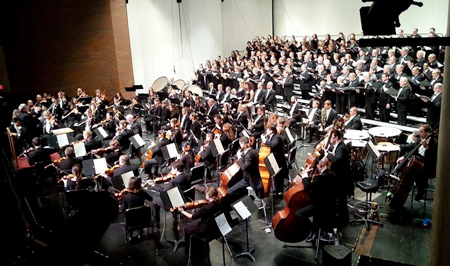by Tom Wachunas

But Verdi did worship the luminary Italian poet and novelist, Alessandro Manzoni, whose work was a galvanizing force in the movement for Italian unification and independence. Soon after Manzoni’s death on May 22, 1873, Verdi visited the grave and declared his intention to compose a requiem mass. The resulting creation, for all its structural adherence to Catholic liturgical rites and theological recitations, stands today as a masterpiece of deeply human expressivity. So, had Verdi given us a strictly religious work, or a new elaboration on the opera form? Critic and conductor Hans von Bülow was the first among many to accept this requiem’s dual nature, calling it, “…Verdi’s latest opera, though in ecclesiastical robes.”
Articulating the right balance and clarity between orchestra, choirs, and soloists to navigate Verdi’s dizzying spectrum of spiritual, psychological, and aural dynamics is a particularly daunting endeavor. It is in fact a monumental challenge, and one beautifully met on April 29 by the Canton Symphony Orchestra and Chorus, along with the Malone University Chorale and Faith United Methodist Church Schola Cantorum, all under the clearly impassioned baton of music director Gerhardt Zimmermann. In full force was his sensitivity to instrumental timbres matched to human voices, delivering the uncanny sensation that brass and percussion can really talk, or that strings can actually sing. Choir and ensemble were consistently mesmerizing in their dialogue.
The operatic nature of the work is such that the choir can be regarded as witnesses to, or commentators on the soloists, who are in turn presented as distinct characters on a journey to judgement day. All of the soloists — soprano Karen Foster, mezzo-soprano Kathryn Findlen, tenor Tim Culver, and bass Nathan Stark — were technically superb, and their singing was invested with heartrending, soaring urgency as well as palpable tenderness. There were only a few passages when the blending of the soprano and mezzo-soprano tonalities and harmonies seemed unsure or slightly out of sync. But such moments never diminished the visceral passion and reverence that both of those soloists poured into, and in turn drew out of the music.
Punctuated by the bone-rattling cracks of bass drums, the recurring Dies Irae (Day of Wrath) interludes were a ferocious assault on psyche and soul. I’ve never heard the orchestra and chorus so piercing, so unashamedly loud. More than once I thought the walls of Umstattdt Hall were on the verge of collapse. Was this God speaking his judgement, or Verdi intoning his own inconsolable rage at human mortality?
In the end, soprano and chorus united in a quiet, bittersweet prayer, Libera Me (Deliver Me), a plea to be saved from eternal death. As the music faded into a suspended hush, the words of Immanuel Kant came to my mind: “Whereas the beautiful is limited, the sublime is limitless, so that the mind in the presence of the sublime, attempting to imagine what it cannot, has pain in the failure but pleasure in contemplating the immensity of the attempt.”
Here, then, was the Canton Symphony Orchestra in all its exquisite sublimity.
Published on ClevelandClassical.com May 5, 2017.
Click here for a printable copy of this article



